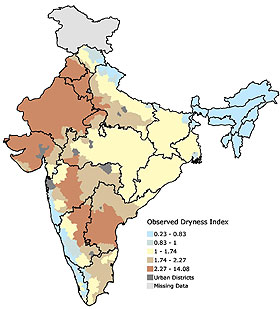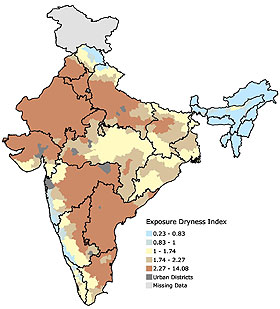|
|
 |
|
|
|
 |
| |
|
|
 |
How are
people changing
the climate?
Basics |
2. What will a
warmer world be like?
How the climate affects people:
Example 2.
|
|
|
|
|
 |
Waiting for the rain in India
January 2003: The state of Andhra Pradesh in India faces drought for the fourth year in a row. "We used to be able to rely on the rains", says peasant Middi Muthialappa.
|
With help from his wife Sumkama and four children, he grows peanuts. For the last few years, the rains have been completely unpredictable.
“Last year all the rain came at once, and it flooded. After that, everything was dry, and the peanut plants wilted away.”
So far, no one knows whether the peasants and farmers in Andhra Pradesh can place the blame on permanent climate changes or simply random variations in the weather. But the signs point toward more unpredictable rainfall in large areas of India in the future. This will create problems for the country’s 680 million peasants and farmers – only a small minority of whom have access to irrigation (water in canals or pipes) to keep their crops alive. Most depend on the rain.
Poor peasants
We are sitting in a small house made of mud – a material that is well-suited for keeping out the blazing heat. A dim light bulb swings from the ceiling. Some villagers own large farms and can afford bicycles, cars, and TVs.
The Muthialappa family has only ten decares of farmland, which is roughly equivalent to one and a half soccer fields. The income from the small crops does not leave them with any money to spare.
|
 |
 |
 |
|
1. Poor: Peasant women in Andhra Pradesh outside their mud house. Photo: Guro Aandahl/CICERO.
|
|
|
The parents, Middi and Sumkama, never learned to read or write. Their eldest son who is 15 attended school but dropped out after the fifth grade and now helps his father in the fields. Their 13-year-old daughter does not attend school either; she helps her mother in the home.
“I have to stand in line for several hours by the water pump in the village to get water,” she says. “In the summer there is drought and then the line gets even longer.”
Her 11-year-old little brother and 8-year-old little sister both attend school. But after school they must help out at home. Middi’s elderly father is sick and stays inside all day.
“He needs medicine and the children need food,” despairs Sumkama. “But we do not have enough money.”
Hungry when the rains fail
When the rains fail, the Muthialappa family risks starvation. They normally harvest about 20 sacks of peanuts, selling 14 of them and keeping the rest as seed. With this money, the family can buy food and other things they need. Last year they harvested only four sacks.
“It’s not even enough for seed,” says Middi.
Middi and Sumkama do not have any savings in the bank. They grow a little food for their own consumption, and own one cow and one bull. The cow provides milk, and the ox is needed to plow, so Middi wants to put off selling the animals as long as he can. But the family needs the money to buy food, seed, fertilizer and insecticides. It is also difficult to find food for the animals when there is a drought.
|
In the dry seasons, Middi, Sumkama and their eldest son take on work on farms that have access to well-water for irrigation and can thus raise crops throughout the year. The pay is poor: about 20–25 Rupi (0.4 Euros) per day for Middi, and 15–20 Rupi (0.3 Euros) per day for Sumkama and their son. This does not go far, even though prices in India are far cheaper than in European countries. It is also difficult to find employment since many people are affected by the drought.
“This year we are dreading the summer,” says Middi. “Drinking water is already scarce and it is only January. I do not dare think about how it will be in May.”
|
 |
 |
 |
|
2. Peanuts: Poor peasants at work separating peanuts from the hay in Andhra Pradesh. These peanuts belong to richer landowners who can afford to invest in trashing machines (the blue one on the picture) and irrigation (water in pipes and canals). The peasants get no money for their work, but they get to use the machine for their small crops. Photo: Guro Aandahl/CICERO (click to enlarge, 264 kB).
|
|
Facts about the Indian climate
India has a tropical monsoon climate. The largest part of India gets rain only during the rainy season, which is sometime between June and September. The rest of the year is generally dry. |
 |
 |
|
3. The map shows areas prone to drought in India today. The bluish colors indicate areas that get more rain than is evaporated from the heat, while the yellow to brown shades indicate regions where evaporation is greater than precipitation. The browner the color, the drier the region. Illustration: CICERO (click to enlarge, 62 kB) .
Next page
|
|
 |
 |
 |
|
4. The map shows a climate model’s estimate of which areas will be prone to drought in a warmer climate in 50 years. More areas than before may become prone to drought. Illustration: CICERO (click to enlarge, 63 kB).
|
|
About this page:
Author: Camilla Schreiner - CICERO (Centre for International Climate and Environmental Research - Oslo) - Norway.
Scientific reviewers: Andreas Tjernshaugen - CICERO, Norway - 2004-01-20 and Dr. Knut Alfsen - Statistics Norway, Norway - 2003-09-12.
Educational reviewer: Nina Arnesen - Marienlyst School, Oslo, Norway - 2004-03-10.
Last update: 2004-03-27.
|
|
 |
|







